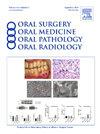毛囊间质瘤:病例报告及文献复习
IF 1.9
3区 医学
Q2 DENTISTRY, ORAL SURGERY & MEDICINE
Oral Surgery Oral Medicine Oral Pathology Oral Radiology
Pub Date : 2025-07-21
DOI:10.1016/j.oooo.2025.04.045
引用次数: 0
摘要
钙化上皮瘤的病因可能是由于CTNNB1基因的突变。该基因编码β -连环蛋白,并在细胞膜上的细胞粘附和细胞核内的信号转导中发挥作用。1880年,Malharbe和Chenantais首次描述了这种病变。当病因被确定为起源于毛囊基质时,从钙化上皮瘤改名为毛囊基质瘤。皮肤病变在儿童和年轻人中更常见,在生命的第一个十年更普遍。最常见的部位是头颈部。它通常表现为皮肤坚硬的皮下结节。材料与方法22岁女性,无明显病史,3年左右右侧耳前区边界清晰,实性实体。检查发现皮肤上覆有红斑和脱落。该实体尺寸为3厘米× 2.5厘米。CT造影剂示:在耳廓前右侧颞区见一轮廓清晰的椭圆形3.9 × 1.6 × 3.6 cm皮下软组织肿瘤,伴密集排列的点状钙化。临床鉴别诊断包括涎腺囊肿、淋巴上皮囊肿及多形性腺瘤。经CT扫描对比,鉴别诊断修改为皮样囊肿、表皮样囊肿和毛瘤,由于病理的浅表、皮下性质。局部麻醉下经耳前入路行切口活检。大体检查显示为红棕色,带有砂砾状硬组织碎片。结果经组织病理学检查,诊断为毛瘤。结论:头颈部毛瘤是一种少见的肿瘤。从业人员应熟悉它,并包括在他们的皮肤病理的鉴别诊断。本文章由计算机程序翻译,如有差异,请以英文原文为准。
Pilomatricoma: case report and review of the literature
Introduction
The etiology of a calcifying epithelioma might be due to a mutation in the CTNNB1 gene. This gene codes for the beta-catenin protein and it plays a role in cell-cell adhesion at the cell membrane and signal transduction in the nucleus. This lesion was first described by Malharbe and Chenantais in 1880. It was renamed from calcifying epithelioma to pilomatricoma when the etiology was identified to arise from hair follicle matrix. Dermatological lesions are more common in children and young adults and more prevalent in the first decade of life. The most frequent location is the head and neck region. It usually manifests as a firm subcutaneous nodule of skin.
Materials and Methods
A 22-year-old female with no remarkable medical history presented with a 3-year history of well-demarcated, firm entity in the right preauricular region. The overlying skin was erythematous and exfoliating on exam. The entity was 3 cm x 2.5 cm. CT with contrast revealed a well-circumscribed oval-shaped 3.9 × 1.6 × 3.6 cm subcutaneous soft tissue tumor with densely packed punctate calcifications are seen involving the right temporal region anterior to the auricle. Clinical differential diagnosis included sialocele, lymphoepithelial cyst, and pleomorphic adenoma. Following the CT scan with contrast, the differential diagnosis was modified to a dermoid cyst, epidermoid cyst, and pilomatricoma due to superficial, subcutaneous nature of the pathology. An incisional biopsy was conducted under local anesthesia using a preauricular approach. Gross examination revealed a reddish brown with gritty hard tissue fragments.
Results
Based on the histopathological interpretation, the entity was diagnosed as a pilomatricoma. Conclusion: Pilomatricoma is an uncommon entity found in the head and neck region. Practitioners should be familiar with it and include in their differential diagnosis of cutaneous dermatopathology.
求助全文
通过发布文献求助,成功后即可免费获取论文全文。
去求助
来源期刊

Oral Surgery Oral Medicine Oral Pathology Oral Radiology
DENTISTRY, ORAL SURGERY & MEDICINE-
CiteScore
3.80
自引率
6.90%
发文量
1217
审稿时长
2-4 weeks
期刊介绍:
Oral Surgery, Oral Medicine, Oral Pathology and Oral Radiology is required reading for anyone in the fields of oral surgery, oral medicine, oral pathology, oral radiology or advanced general practice dentistry. It is the only major dental journal that provides a practical and complete overview of the medical and surgical techniques of dental practice in four areas. Topics covered include such current issues as dental implants, treatment of HIV-infected patients, and evaluation and treatment of TMJ disorders. The official publication for nine societies, the Journal is recommended for initial purchase in the Brandon Hill study, Selected List of Books and Journals for the Small Medical Library.
 求助内容:
求助内容: 应助结果提醒方式:
应助结果提醒方式:


